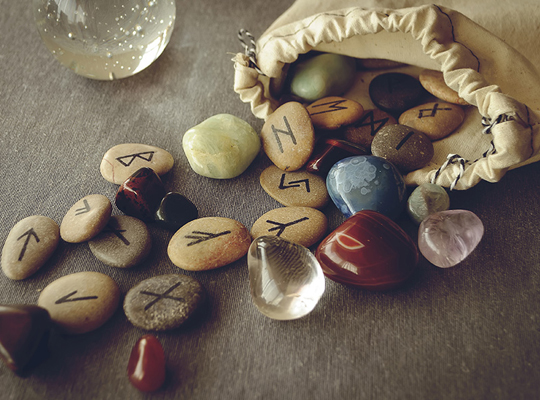Runes are an ancient Germanic alphabet, used for writing, divination and magick. They were used throughout northern Europe, Scandinavia, the British Isles, and Iceland from about 100 B.C.E. to 1600 C.E. Runic inscriptions of great age have even been found in North America, supporting stories that the Vikings arrived in the Americas long before Columbus.
Runes are an oracle from which one seeks advice. They work best if you detail your current circumstances and then ask a specific question. Rune readings are sometimes obscure. They hint toward answers, but you have to figure out the details. This is when the rune casters intuition becomes paramount. Sometimes the Runes “sing” to me, and their meaning becomes instantly clear.
Runic divination or “rune casting” is not “fortunetelling” in the sense that one actually sees the future. Instead, runes give one a means of analyzing the path that one is on and a likely outcome. The future is not fixed. It changes with everything one does. If one does not like the prediction, one can always change paths.
Runes are a method of divination similar to the Tarot or the I Ching. The difference is that Runes are a set of 25 stones instead of 78 cards or a set of sticks with patterns. As with the Tarot, most of the Runes may be right side up, or upside down, the meaning differing with the case. There are also some Runes that cannot appear up-side down. In practice, the Runes may be made of any material; ceramic, stones, sticks, or drawn on cards.
Since ancient times, runes have been used for divination and magic, in addition to writing. The word “rune” actually means mystery, secret or whisper. Each rune has esoteric meanings and properties associated with it, beyond its mundane meaning and phonetic value. Each translates into a word or a phrase signifying concepts important to the early peoples who used them, representing the forces of nature and mind. Each rune has a story attached to it, a relationship to a Norse God.
Runic alphabets first appeared among German tribes in central and eastern Europe. Some runes symbols are likely to have been acquired from other alphabets, such as the Greek, Etruscan, and the Early Roman. The runes were made of straight lines to make the characters suitable for cutting into wood or stone. The earliest runic inscriptions on stone are dated to the late 3rd century AD, although it is probable that runic alphabets had been in use for some centuries before.
TYPES OF RUNES
ELDER FUTHARK
ELDER FUTHARK
The Old Germanic Runic alphabet or “Elder Futhark” contains 24 runes. The first six runes of the alphabet spell out the word “FUTHARK”. As the runes spread northwards into Scandinavia, some rune symbols were dropped and the alphabet was reduced to only 16 runes. Between 400 and 600 AD, three Germanic tribes, the Angles, the Saxons and the Jutes, invaded Britain. They brought the runes with them. The forms of several of the runes changed, notably the runes for A/O, C/K, H, J, S, and Ng. Also, changes in the language led to nine runes being added to the alphabet to compensate for the extra sounds, and several runes were given different corresponding letters. This alphabet, expanded to 33 symbols, has become known as the Anglo-Saxon Futhorc. The rune names themselves have been passed down relatively intact. Although no manuscript exist listing the names of the older, Germanic runes, the Anglo-Saxon and Scandinavian rune poems agree to such an extent that their common origin can be deduced. Here you can see number of Runic Scripts.
The Runes are divided into three Aettir or groups of eight. Runic divination, “runecasting”, is not “fortune telling”. Runecasting works deeply with the subconscious. The rune pouch with its runic symbols represents the entire universe. As one poses a question, one’s entire conscious and unconscious mind is focused toward that question, so that the runelots selected are not truly random selections, but rather choices made by the subconscious.
Runecraft operates on an ancient form of psychology. Even back in Viking times, there was a remarkable understanding of the human psyche. They recognized cause and effect, and the interconnectedness of all things. The word to describe this interconnectedness was “wyrd”, which was eventually perverted into the modern meaning of “weird”. It did not originally mean something unusual or strange. Rather, it referred to the far-reaching effects of that which one does. The concept of “fate” was also not as we know it now. Instead of a helpless predestination, “fate” meant a destiny created by one’s earlier actions. Wyrd was pictured as a web, like that of a spider. The symbology is excellent. When the spider steps onto a thread (a path) the vibrations affect the entire web and that which is contained within the web, just as our actions affect our immediate world and those around us, and the actions of others affect our lives.
When one does a runic reading, one usually addresses a particular issue, and examines the past, the present and the “future”, or rather “what will be if one follows the path one appears to be on”. The future is always perceived as mutable, changeable. The runic reading is done as an evaluation process, not as fortunetelling. One has an opportunity to look at what has occurred in the past (regarding the issue being questioned), what is occurring right now, and what direction one is headed. A runecaster does not see the future. He/she examines cause and effect and points out a likely outcome.

